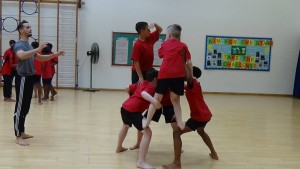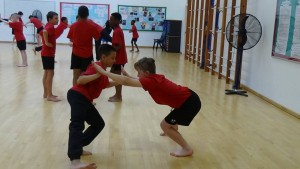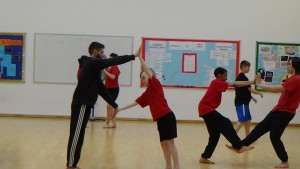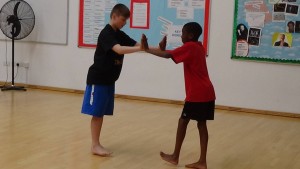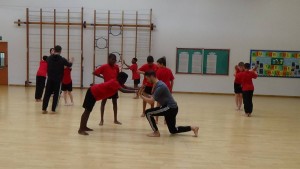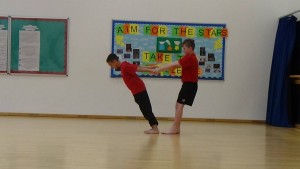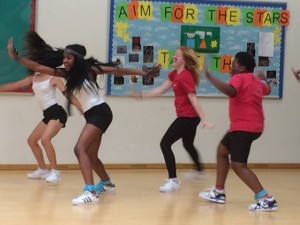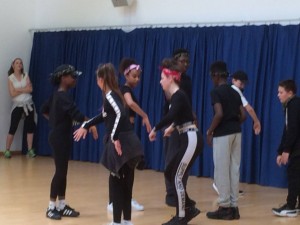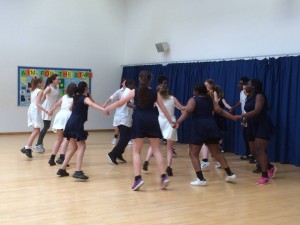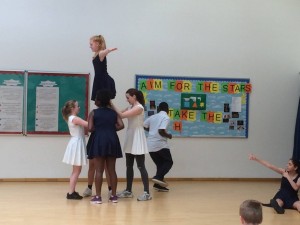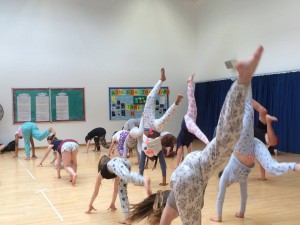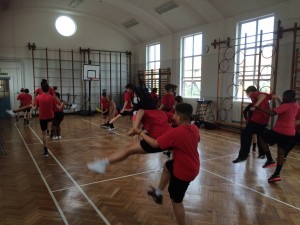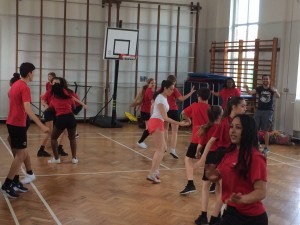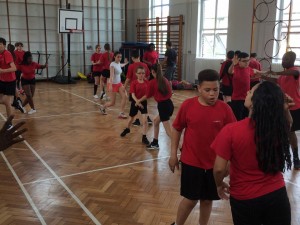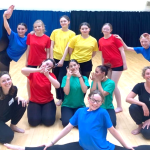Dance is beneficial to young peoples development physically, culturally and emotionally. It is a unique subject that blends artistic practice with physical activity. Dance enhances self-esteem, confidence and widens aspirations as it offers opportunities for young people to perform both locally and regionally. Dance allows young people who lack confidence to communication verbally an opportunity to express themselves physically.
Dance

Our aim is to develop an atmosphere where involvement, creativity and confidence can flourish for all. Dance makes a unique contribution to the education of all students. We recognise that dance can enrich an individual’s life through the development of their cultural and social awareness. Through its use of non-verbal communication students are able to participate in a way which differs from any other area of learning. This allows every student to succeed highly in any or all of the strands of dance; performance, composition and appreciation.
Our aim is to develop an atmosphere where involvement, creativity and confidence can flourish for all. Dance makes a unique contribution to the education of all students. We recognise that dance can enrich an individual’s life through the development of their cultural and social awareness. Through its use of non-verbal communication students are able to participate in a way which differs from any other area of learning. This allows every student to succeed highly in any or all of the strands of dance; performance, composition and appreciation.
Although Dance falls under PE National Curriculum, at The Jo Richardson Community School, Dance is taught under the Performing Arts Curriculum. Year 7 and 8 will have half a term on dance covering two different units and 9 has a Dance lesson once a week throughout the year.
The students study the following units of work designed to cover the three strands of dance, Choreography, Performance and Appreciation
YEAR 7
- Intro to Dance – This unit teaches students the fundamental principles of dance (Action, Space, Dynamics, and Relationships). They will learn to create movement using a theme, teaching them how to be a choreographer using problem-solving skills to create inspiring and interesting movement.
- World Dance – Students will study a range of movement from two diverse cultures Africa and India. Pupils will learn the context of where these styles originated from as well as how to perform and appreciate them accurately.
YEAR 8
- Chance – This unit is designed as an introduction to dance in education, which allows students to acquire the basic choreography skills needed in dance. Students must learn a teacher taught sequence that includes all five basic actions: jump, turn, travel, gesture, and stillness.
- Art – This unit teaches students to use art as a stimulus for movement. Students will study work from artists such as Picasso, Lowry, and Banksy. They will learn to analyse and appreciate the works taking potential ideas for movements as well as using the context behind the paintings to develop ideas further at a GCSE level.
YEAR 9
- Message in a bottle – This unit uses a professional work with a mature stimulus to inspire choreography and enhance motif development.
- Poetry – In this unit students will learn how to use poetry as a stimulus for movement. They will analyse and break down the poems to understand the structure and context of how the words can be used to create effective choreography
- The Urban Dance Timeline – Students will learn the origins of Urban dance and how this modern-day phenomenon of street dance was first formed. Students will study breaking, tutting, whacking and b-boying
- World Dance II – Students will study three different dance cultures and research and perform a dance culture of their choice. Pupils will learn the social and historical context of where these styles originated from as well as how they have developed today.
- Shadows – students will learn how to analyse a professional work and explore the genre of physical theatre. Students will focus on the use of contact work and lifts to communicate themes as well as strong characterisation.
- Dance Project – This unit is taken directly from the GCSE spec. Pupils will choose a stimulus, dance style and group size of their choice to create their own choreography. They will need to research the stimulus in detail to ensure they have a range of ideas. Pupils will be marked using GCSE criteria.
In Year 10 and 11 we currently offer AQA GCSE Dance.
Why Dance?
The study of dance as an art form contributes to your artistic, social, emotional and physical development. Dance also supports your development in many industry skills of the working world: Making a positive contribution, developing team and leadership skills, artistic understanding, making informed and critical judgements, developing creative thought and action, appreciation of diversity in cultures and traditions, innovative thinking, speaking and listening through discussion, evaluation and appreciation.
It is proven that Dance sparks and ignites neutrons of the brain which can encourage learning across all curriculum subjects.
By breaking a sweat you can become a better learner, as well as lifting your mood, sharpening your intellect and overall functioning.
Assessment
60% Practical Exam
- Performance 30%
- A Solo Performance: Students will learn to accurately perform 3 set phrases, replicating action, dynamic and spatial content with precision
- Duet/trio performance: Students will learn to perform as part of a duo/trio demonstrating all expressive skills such as projection, use of focus, musicality and phrasing.
- Choreography 30%
- Solo or Group Choreography and Choreography Log: Students will learn how to respond creatively to an externally set stimulus to choreograph their own complete dance. Students must create a log following the choreographic process of research, improvisation and selection.
40% Written paper (1hour 30mins)
Students will answer questions covering the following topics…
- Knowledge and understanding of choreographic processes and performing skills
- Critical appreciation of own work
- Critical appreciation of professional works
Careers and further study
After studying GCSE Dance you can progress to A level dance followed by studying at university level in a specific area.
There are a range of careers that you can access as a result of studying dance. Here are just a few
- Choreographer
- Community Dance Practitioner
- Costume/Set Designer
- Dance Performer
- Dance/Arts Officer
- Dance Education Specialist
- Dance Film Maker Dance
- Movement Therapist
- Dance Journalist Dance
- Lecturer or Academic Researcher
- Dance Photographer
- Dance Producer
- Dance Teacher
At Key Stage 4 formal homework is regularly set. Students are also required to be available for regular rehearsals as appropriate for performances and coursework.
At JRCS we offer AQA A Level Dance.
The qualification encourages learners to develop knowledge, skills and understanding of:
- techniques and approaches required in one or more performing arts areas of study
- working methods linked to industry practice
- how their own skills and aptitudes could be best employed in further study and/or work within related sectors
- breadth of sector through exploring its products and processes
- outcomes of industry practice in terms of people, products, services and contexts
- Social, historical and cultural influences.
In addition, the qualification develops ways of working that encourages learners to:
- develop their skills, technique and work attitudes to a standard that allows progression to further training or work
- apply working methods used by professionals as individuals and in teams, as well as with audiences and commissioners
What’s assessed
- Choreography and performance of a solo
- Performance in a duet/trio
- Two areas of study – chosen from five (one compulsory area of study).
- The reflection and understanding of own choreographic and performance practice.
How it’s assessed
- Practical exam
80 marks
50% of A level
- Written exam: 2 hours
80 marks
50% of A level
Extra-Curricular Activities
The Dance department offers a range of trips to see professional dance performances at prestigious theatres in London as well as musicals and a chance to take part in professional workshops.
| Monday | |
| Tuesday |
Hip Hop Club with Arizona in DA1 3.15 – 4.15pm
|
| Wednesday |
KS3 Dance Choreography Club DA1 10am – 10.25am Yr. 10 GCSE Dance Intervention DA1 1.30 – 2pm
|
| Thursday |
Yr. 11 GCSE Dance Intervention DA1 3.15 – 4.30pm |
| Friday |
At the core of our approach to marking at JRCS is task marking.
In non-practical subjects one substantial piece of work will be task marked at least once every eight hours of teaching. Students will respond to the tasks and they will be checked by staff. In between that time students’ work may be peer or self-assessed or briefly checked by staff.
It is likely the same piece of work will be assessed for literacy. Staff will mark work using the literacy marking code:
| Sp | spelling mistake |
| P | punctuation mark missing or incorrectly used |
| Voc | incorrect use of vocabulary |
| ^ | word missed out of sentence |
| ~ | unclear meaning or grammar within a sentence |
| // | new paragraph required |
| CL | capital letter error |
Levelling and Assessment
KS3
To develop a growth mindset and reflect ‘life after levels’ work in KS3 books will not usually be levelled; assessment will be formative and highlight how students can improve. Students will record areas of strength and development on their ‘reflection sheets’ which will be at the front or back of the book. At the end of each term a level is reported for students in each subject, which reflects all their work over that term. These are found on students’ pale yellow progress cards, which are stuck into their planners. These cards show students whether they are in line to meet their end of key stage target. With the move away from National Curriculum levels, the school is trialling a new ‘skills thermometer’ and 1 to 9 levelling in English. Other KS3 subjects will be using NC levels for the remainder of this year.
KS4
KS4 practice exam questions and mock exams are likely to be graded. This work might not be in student books. Students will record grades and areas of strength and development in their ‘reflection sheets’ which will be at the front or back of the book. All students receive an attainment and predicted grade at the end of each term. These are found on their pale yellow progress cards, which are stuck into their planners. These cards show students whether they are in line to meet their end of key stage target.
KS5
At KS5 students take a series of VIMAs (Sixth Form Milestone Assessments) during their course. Students receive developmental comments to help them improve their work. Each VIMA result includes four parts: the grade for that assessment, a comparison of the grade with their expected progress grade (EPG), a Learning Capability mark and a prediction of their end of year grade (PEG). The outcomes of these assessments and other graded work will be in student folders. They are also sent home to parents. A summary of VIMA marks and the students’ expected progress grade is also recorded in their planner.
Further information
At Key Stage 3 each complete unit is marked and National Curriculum levels are shared. The students are aware of the grading criteria and regularly review and set targets to move up to the next level. At the end of each unit students complete an Assessment for Learning booklet to identify progress, record results and set targets for the following unit of work.
At Key Stage 4 and 5 the students are set aspirational targets and are mentored to understand the requirement to achieve these.
Staff from Dance
England, S
Head of Dance
Hazlewood, L
Instructor of Dance
Jones, R
Teacher of PE
Simpson, R
Assistant Headteacher
If you have any queries or concerns, please do not hesitate to contact the school office on 020 8270 6222 or contact the Head of Dance, Miss S England at SEngland@jorichardson.org.uk




